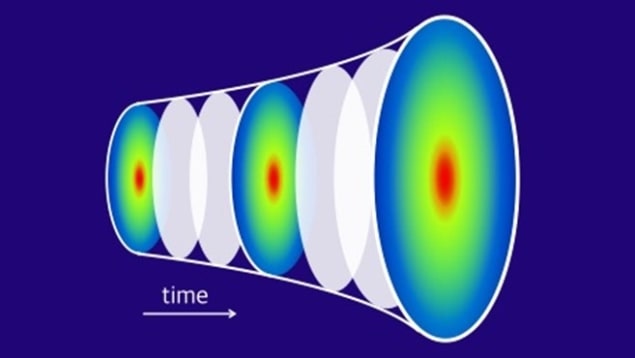
Unfortunately for the field of cosmology, there is only one universe. This makes performing experiments in the same way as other scientific fields quite a challenge. But it turns out that the universe and the quantum fields that permeate it are highly analogous to quantum fluids like Bose–Einstein condensates (BECs), at least from a mathematical point of view. These fluids can be the subject of experiments, allowing cosmology to be studied in the lab.
In a paper published in Nature, researchers at Heidelberg University in Germany have for the first time used a BEC to simulate an expanding universe and certain quantum fields within it. This allows for the study of important cosmological scenarios. Not only is the universe currently expanding, but it is believed that in the first fractions of a second after the Big Bang it underwent a period of extremely rapid expansion known as “inflation”. This process would have expanded the microscopic fluctuations of quantum fields in the early universe to the size of galaxy clusters, seeding the large-scale structure of our universe today.
To study this cosmological model, the researchers began with a flat droplet of BEC composed of potassium-39 atoms in an optical trap. This was the “universe” part of the simulator, and it had a spatial curvature that was related to the average density of the BEC. The quantum field part was played by phonons, quantized packets of sound energy moving through the fluid. These served as analogues to photons and other quantum fields fluctuating in the actual universe.
Quantized vibrations
The phonons were created by firing a laser at the BEC. When the laser was switched off, a phonon vibration spread through the droplet. Quantum particles follow trajectories determined by the curvature of the spacetime in which they move. Hence, by studying the trajectory of these phonons, the researchers were able to confirm that the simulated universe had the spatial curvature they were aiming for.
Finally, the expansion of space was cleverly instituted by adjusting the strength of interactions between the atoms in the BEC with magnetic fields. Decreasing the interaction strength also decreases the speed of sound, which achieves the same effect as a corresponding expansion of space. The idea is that in an expanded space, it takes longer for a signal to traverse its length. So instead of physically expanding the droplet, one can produce the same effect by slowing down the signal.

Quantum fields and a dynamic space–time interact in complex ways. One particularly curious feature is that an expanding space can produce particles – an effect similar to the creation of Hawking radiation by black holes. By tuning the scattering length of the BEC, the scientists experimented with “ramping” up the size of their mini universe in different ways, corresponding to uniform, accelerating and decelerating expansions.
Seeding large-scale structure
What they observed did in fact correspond to the production of phonons, as expected. As these phonons interfered with one another, they produced patterns of random density fluctuations in the BEC. They had thus observed the same phenomenon predicted to be responsible for the seeding of large-scale structure in the early universe.
Even though the simulated universe differs greatly from our own – for example, it has only two spatial dimensions and a different overall curvature – these simple tools may help scientists solve difficult problems in the future.

Ultracold atoms move closer to simulating the early universe
“Already simplified cosmological models, like the one we considered, can contain some of the not-well-understood phenomena that are present in our universe,” explains Marius Sparn, one of the co-authors of the Nature paper.
Even this proof-of-principle experiment contained intriguing surprises. Not only were phonons produced by the expansionary ramps, but the characteristics of their collective oscillations depended on the type of ramp performed. The phonons contained information that revealed whether the expansion was constant, accelerating or decelerating. This interesting feature, which Sparn says was only understood through the interplay between theory and experiment, demonstrates the possibilities of pursuing these lab-based studies.
In particular, the researchers hope to use these tools to peer back into the earliest moments of the universe and probe the hypothesis that the universe’s large-scale structure has a quantum origin. Co-author Stefan Floerchinger asks “Is the standard textbook theory complete, or are there ways to look back to the period before inflation by investigating quantum fluctuations, correlations and entanglement in more detail?”
